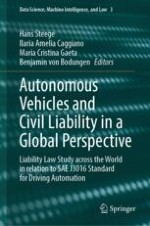In the automotive sector, digitalisation, connectivity and automation are rapidly expanding. In tomorrow’s vehicles, human beings will merely be passengers – which raises a host of complex legal issues regarding accidents involving self-driving vehicles. This book is the first to offer a comprehensive, global overview of civil liability regimes for all levels of vehicle automation in jurisdictions that represent some of the most important markets for the automotive industry. After a technical introduction to how self-driving cars work, the individual chapters analyse the liability for driving automation at SAE J3016 levels 0 through 5 from a country-specific perspective. All chapters were written by experts in the field and follow a uniform legal structure. Hence, the book offers an essential comparative analysis of similarities and differences in the jurisdictions examined, while also providing suggestions for future legislative changes at the national and international level. The book is not only relevant for legal scholars and practitioners but will also be of particular interest to anyone involved in the design, manufacture, distribution and operation of self-driving vehicles.
